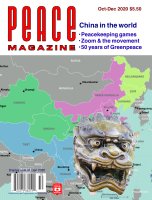
Peace Magazine Oct-Dec 2020, page 4. Some rights reserved.
Search for other articles by Metta Spencer here
We canít hug each other by video (to Doug Rocheís dismay) but otherwise Zoom is just what we need now. Nationalistic xenophobia has replaced globalization, especially during this pandemic, and anti-regime civil resistance movements are failing around the world. Zoom meetings let us counter both deplorable trends by discussing more (and more widely) before acting. †
With Facebook and Twitter it is easy to bring crowds of strangers to street demonstrations, but usually such demonstrations now fail (e.g. in Hong Kong and Belarus). In previous times the movementís leaders had emerged from years of strategizing sessions, and after winning were ready with plans. Now Twitter brings strangers together briefly, but they disperse after each action, building no movement.
Fortunately, a plan is underway to revitalize the Canadian peace movement, thanks to World Beyond War, which held several Zoom meetings this summer. Everyone is enthusiastic, though we are still barely getting acquainted. Weíre debating whether to create an organization or a network.
Peace Magazine favors the latter because a large, diverse community of activists is more effective than a single umbrella organization of NGOs.
Organizations are ideal for accomplishing a well-defined project. They are hierarchical, with information flowing through channels to the specific roles in a “chain of command.” Decisions, even when reached by voting, are binding on all members, since there must be common goals and a common ideology. This limits membership size, for partial dissenters donít join. When an organizationís members are NGOs, they often have to compete for resources with their larger organization; the local grassroots groups may be weakened, not strengthened, by belonging.
Networks, on the other hand, are egalitarian. Every member is free to contact every other member, and there is no chain of command. They are ideal for discussing issues, but not for doing specific projects.†If member organizations want to hold a street demonstration or boycott, say, they can use the network to communicate with other NGOs and form an ad hoc organization with a specific plan for that action. But a network itself does not take positions on issues or organize actions; it simply facilitates interaction among members. Conceivably, all members will join the same action, but if so, they do so as a sub-group organization, not as the network, which should remain flexible enough to change goals and include diverse groups. This is the kind of community that the peace movement needs, both globally and in Canada.

Peace Magazine Oct-Dec 2020, page 4. Some rights reserved.
Search for other articles by Metta Spencer here